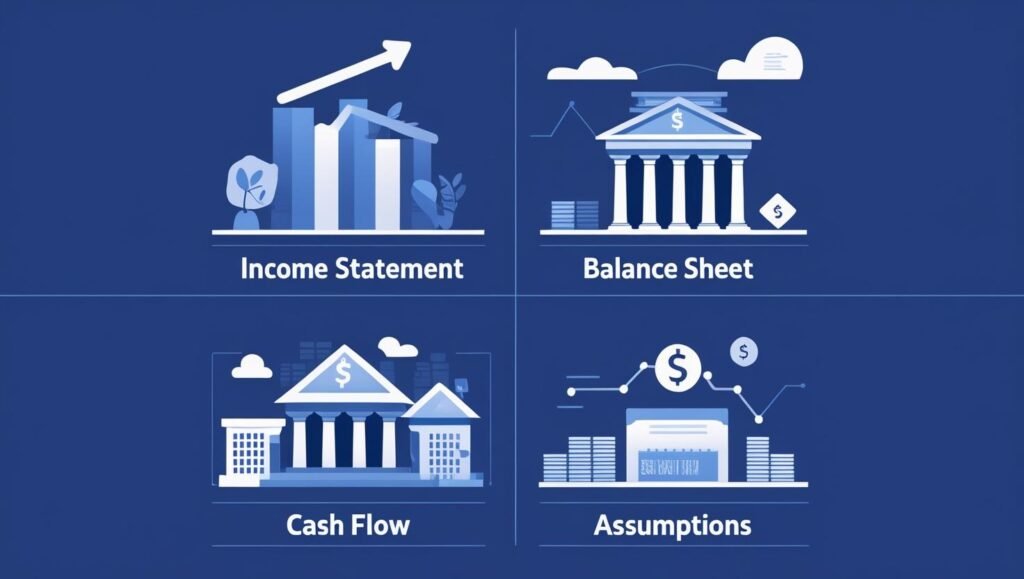Consider yourself in charge of a small company. Everything is going smoothly until an unexpected financial crisis arises. You had no financial roadmap, so you didn’t anticipate it. Projected financial statements can help you make better business decisions, plan for the future, and avoid surprises. Financial foresight is a need, not a luxury, in today’s cutthroat environment. The future of your company can be significantly influenced by your comprehension and application of financial projections, regardless of your level of experience as a finance professional, seasoned business owner, or startup founder.
📘 What Are Projected Financial Statements?
Your income statement, balance sheet, and cash flow statement are all updated for the future in projected financial statements, also known as forecasted or pro forma financials. 🔍 They make predictions about what will happen based on assumptions about revenue, expenses, and market conditions rather than reflecting what has already occurred. They act as your financial GPS, assisting you in setting reasonable objectives, testing hypotheses, and making well-informed decisions.
💡 Why Are They Important for Businesses?
The following justifies the necessity of financial projections for all businesses, regardless of size:
🔹 Strategic Planning: Before making decisions, consider the way they will affect your finances.
🔹 Investor confidence is a must for obtaining loans or increasing capital.
🔹 Risk management: Recognize possible weaknesses and get ready in advance.
🔹 Performance tracking: Establish objectives, gauge results, and adjust as necessary.
📈 Think of projected statements as your business’s financial crystal ball.
🧩 Key Components of Projected Financial Statements
A complete set of projections includes:
📄 1. Projected Income Statement
It shows the calculation of profit, expenses, and income. It shows you the potential profitability of your business future.
💼 2. Projected Balance Sheet
The anticipated balance sheet displays your future assets, liabilities, and equity. Good for evaluating the financial health of the business.
💸 3. Projected Cash Flow Statement
Projected Cash Flow Statement predicts the amount of money that will come in and go out, which is crucial for the business’s liquidity planning.
🧾 4. Assumptions
These serve as the foundation for your projections. Always base them on accurate information, data, patterns, and insights.
🛠️ How to Prepare Projected Financial Statements

Follow these steps to prepare financial projections:
1. Review Historical Data to look for trends in your previous performance.
2. Make Reasonable Assumptions by using market research and industry standards.
3. Make Use of Tools so you can put together your projections with the aid of MS Excel, accounting software, or templates.
4. Take into Account Business Changes as the numbers are changed by hiring, price changes, and growth plans.
5. Create Scenarios so that you have flexibility with best-case, worst-case, and expected projections.
⚠️ Mistakes to Avoid
↛ Being Too Optimistic – It is unappropriated to consider hope as a strategy.
↛ Forgetting the Market – Forecasts become unreliable when economic trends are ignored.
↛ One-Time Projections – Update on regular basis to reflect modification and relevance.
💬 Projections are only valuable when they’re based on reality.
📚 Real-World Example: Predictive Action
A local based retailer intended to open two more stores at different locations. The owner understood using comprehensive financial projections that if the business is expanded too quickly, she would run out of money in the second year. She changed her strategy, postponed hiring, and opened one branch instead. As a result, she has consistent growth free from financial pressure.
🎯 That is the power of projected financial statements.
🧭 Final Thoughts: Your Strategy to Business Success

Projected financial statements are strategic documents that promote business success and confidence for investment, clarity about the growth, and control over business. It is important to consider it a crucial requirement rather than a financial formality.



